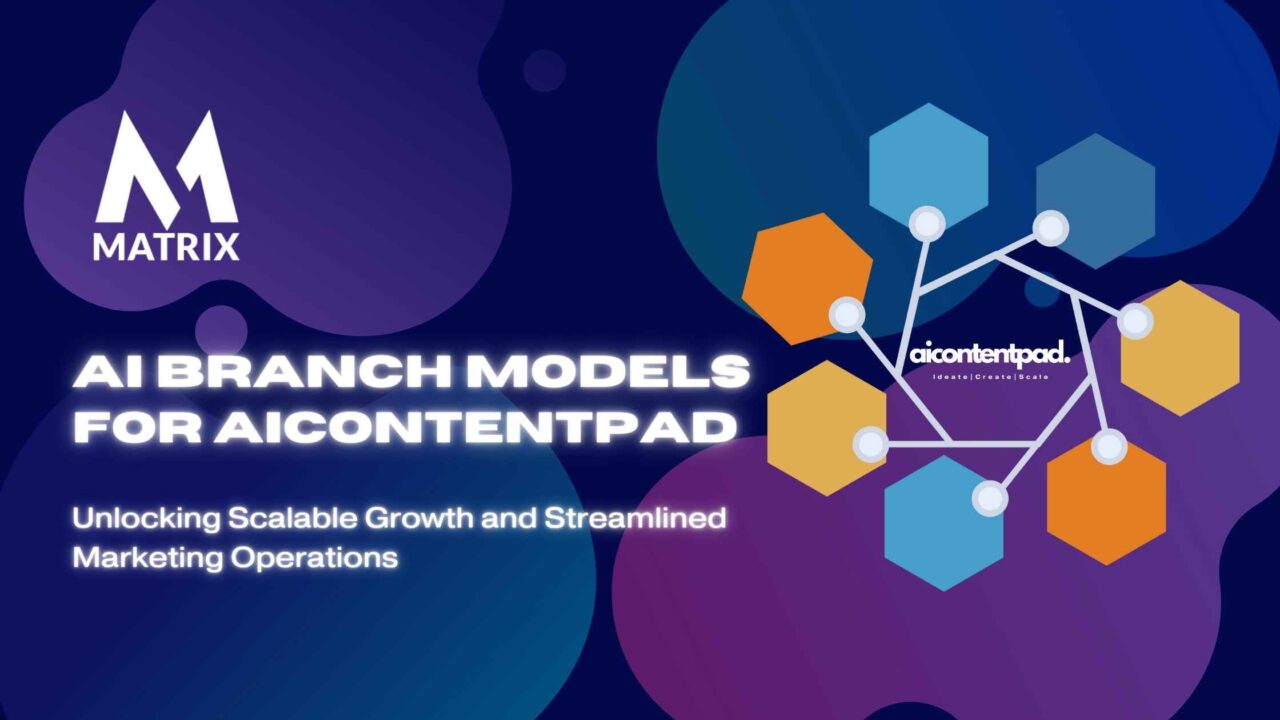AI Branch Models Have Revolutionized Marketing
In the age of digital transformation, marketing managers are constantly seeking innovative ways to stay competitive and relevant. But how?
With evolving market dynamics, technology-driven strategies, and data-centric decision-making, businesses need models that adapt quickly to their unique needs.
MatrixLabX and Matrix Marketing Group have introduced a groundbreaking approach through Branch Models, offering highly targeted, scalable solutions that address industry-specific challenges.
Matrix Marketing Group’s AI Branch Models for AIContentPad can be compared to a tree with specialized branches, each representing a unique function or service designed to meet specific content needs.
Just as a tree’s branches extend outward to capture sunlight and nourish the entire structure, AIContentPad’s models are tailored to target different aspects of content creation—blog writing, SEO optimization, social media content, or visual design.
Each branch feeds into the core objective: efficiently delivering comprehensive, intelligent content solutions. The more robust and diversified the branches, the stronger and more adaptive the overall system becomes, enabling brands to thrive in the competitive digital landscape.
This comprehensive article will explore AI Branch Models, their significance for marketing managers, and how they can be applied across different industries and vertical markets.
Accelerated Implementation
Using Matrix’s AI Branch Models reduces businesses’ time to value. By leveraging pre-built processes, organizations avoid building everything from scratch, allowing them to implement marketing systems more quickly and efficiently.
The AI Branch Models also reduce the risk of failure since they are based on proven processes for each industry’s nuances.
We’ll also explore how these models streamline marketing strategies, improve decision-making, and drive success.
1. What Are AI Branch Models?

Branch Models, a concept pioneered by MatrixLabX and Matrix Marketing Group, is a sophisticated framework designed to offer marketing solutions customized to the unique needs of different industries and vertical markets.
AI Branch Models are scalable and adaptable systems that use AI agents like AIProdPad, AIContentPad, and AIBrandPad. The agent runs the Branch Models to craft marketing strategies and content for companies facing specific industry challenges.
AIProdPad explains that an AI agent runs a specific branch model for product development and marketing, while AIBrandPad generates communication frameworks and corporate governance.
Think of Branch Models as trees with multiple branches. Each branch represents a unique path for a particular market or segment, allowing marketing managers to navigate distinct requirements without compromising the overall growth strategy.
Branch Models are tree-like structures with multiple branches. Each branch caters to a specific market or segment, enabling marketing managers to address diverse needs while maintaining the overall growth strategy.
Industry Best Practices
These models embed industry best practices, meaning they incorporate processes and procedures that have been proven effective in leading companies within that industry.
For example, a Matrix Branch Model for manufacturing might include best practices for the following:
Here are three best practices for marketing managers in the manufacturing industry to effectively drive growth and engagement:
1. Leverage Data-Driven Insights for Targeted Campaigns
- Best Practice: Utilize data analytics to segment customers and identify key market trends. By analyzing customer data, production patterns, and supply chain metrics, marketing managers can create highly targeted campaigns that resonate with the right audience at the right time.
- Example: Use predictive analytics tools to forecast demand trends and promote specific products that align with seasonal or market fluctuations, optimizing spending and boosting conversion rates.
2. Adopt Content Marketing for Thought Leadership
- Best Practice: Develop and promote educational content demonstrating expertise in manufacturing, innovations, or solutions to industry challenges. White papers, case studies, and technical blogs can position the brand as a thought leader while addressing potential clients’ pain points.
- Example: Create a series of case studies showcasing how your manufacturing solutions improve efficiency or reduce costs, and promote these across industry-specific platforms and LinkedIn to attract decision-makers.
3. Integrate Digital and Offline Strategies for Seamless Buyer Journeys
- Best Practice: Combine digital marketing efforts (SEO, PPC, social media) with traditional offline methods (trade shows, printed materials) to offer a consistent brand experience across all touchpoints. Ensure potential clients can move smoothly between online research and offline sales interactions.
- Example: Build an omnichannel strategy where prospects discover your solutions through online ads or blogs, request a quote through a user-friendly website, and engage with sales reps at industry trade events. Maintain cohesive messaging and tracking across all channels.
These practices help manufacturing marketing managers optimize campaigns, establish authority in their niche, and create consistent customer experiences across digital and offline platforms.
These models tailor approaches to niche markets, aligning marketing efforts with the unique challenges faced by various industries, such as B2B tech companies, healthcare providers, manufacturers, retail and eCommerce, financial institutions, construction, traveling, and hospitality.
Matrix Marketing ROI Calculator
Key Elements of AI Branch Models:
- Customization: Tailored approaches based on industry and vertical-specific data and models.
- Scalability: The ability to adjust strategies and scale marketing efforts quickly.
- Adaptability: Flexibility to evolve with changing market dynamics.
- Data-Driven Insights: AI and machine learning-backed performance.
- Market Intelligence: Competitive benchmarking and trend forecasting for better strategic planning.
2. Why AI Branch Models Matter to Marketing Managers

Regardless of their industry, marketing managers face universal challenges: understanding their audience, maintaining competitive positioning, and driving ROI.
Traditional “one-size-fits-all” marketing solutions often fail to meet the specialized needs of industries with distinct customer behaviors, regulatory environments, and market conditions.
This is where Branch Models come in. They bridge the gap between generic marketing strategies and highly specialized industry needs, with AI agents like AIContentPad, AIBrandPad, or AIProdPad running AI Branch Models to give you results faster, better, and cheaper.
Here’s how:
a) Industry-Specific Solutions
Marketing managers in healthcare, for instance, deal with compliance regulations such as HIPAA, while managers in manufacturing may need strategies to tackle global supply chain disruptions. Or the government with FEDRamp regs.
Branch Models offer frameworks addressing these distinct challenges, ensuring marketing campaigns remain relevant, effective, and compliant.
b) Efficient Use of Resources
Branch models streamline marketing operations by using advanced engineering and AI grounding. This enables marketing managers to allocate their resources—time, budget, and personnel—more efficiently.
By analyzing historical data, current trends, and AI-driven agents, managers can focus on high-impact activities and reduce wasted effort on campaigns that don’t align with their industry’s current trajectory.
c) Improved Decision-Making
Data-driven decision-making is essential for modern marketing. Branch Models provide marketing managers with robust datasets running Branc Model AI agents, allowing them to make informed decisions.
The models offer insights into current market conditions and potential future trends, enabling proactive rather than reactive strategies.
3. Branch Models in Action: Applications in Different Industries
Let’s explore how Branch Models can be applied across various industries and vertical markets.
Predesigned industry models for marketing are strategic frameworks tailored to meet the specific needs, challenges, and opportunities within a given industry or vertical market.
These pre-built models incorporate industry-specific best practices, regulations, consumer behaviors, and market dynamics.
They offer a structured marketing approach for industries like healthcare, technology, manufacturing, financial services, retail, and more.
These models are especially beneficial for marketing managers who must develop targeted strategies quickly and precisely without starting from scratch.
Let’s explore what these predesigned models typically include and how they work across various sectors.
Key Components of Predesigned Industry Models
- Industry-Specific Algorithms and AI-Driven Insights:
Predesigned models use AI-powered industry-focused algorithms to analyze data patterns and trends specific to that sector. For example, in retail, AI might predict consumer buying behavior, while in healthcare, it might analyze patient engagement data. The LLM models are trained and tuned with public, private, or hybrid models. - Compliance and Regulatory Considerations:
Each industry has unique compliance requirements (e.g., HIPAA for healthcare, GDPR for data privacy). Predesigned models have built-in guidelines to ensure marketing campaigns adhere to these standards, avoiding potential legal and financial repercussions. - Pre-Built Customer Journey Maps:
These models often come with ready-to-use customer journey maps tailored to the typical buyer personas within that industry. For instance, the journey of a B2B tech customer is far different from that of a retail shopper, and these models accommodate those differences. - Industry-Specific KPIs (Key Performance Indicators):
Predesigned industry models include KPIs that align with specific business goals for that sector. For example, customer lifetime value (CLTV) might be crucial in financial services, whereas time to conversion might be more critical in eCommerce. - Optimized Marketing Channels:
Different industries rely on different marketing channels for effective engagement. Predesigned models highlight the most effective channels—SEO, social media, email marketing, trade shows, or content marketing—based on the industry’s customer preferences and behaviors. - Templates for Campaigns and Messaging:
Branch Models often include customizable messaging templates, campaign ideas, and content suited to a particular sector’s unique language and tone. For instance, tech companies may prioritize data-driven, technical content, while retail focuses on emotional, lifestyle-oriented messaging.
Examples of AI Branch Model – Predesigned Industry Models in Action
Healthcare

Healthcare marketing is complex, with layers of regulations and ethical considerations.
Branch Models tailored for the healthcare industry focus on data privacy compliance, patient engagement strategies, and multi-channel communication.
AI-driven insights help healthcare marketing managers identify key touchpoints in the patient journey, optimize engagement, and ensure compliance with industry standards.
For example, MatrixLabX has developed a healthcare-specific branch model that assists marketing teams in navigating the complexities of launching new products, from pharmaceuticals to medical devices, while adhering to FDA regulations.
A predesigned marketing model for healthcare would focus on the following:
- Regulatory compliance: Incorporating HIPAA guidelines and local health regulations.
- Patient engagement: Developing trust through informative content (e.g., blogs, patient testimonials) while leveraging channels like email newsletters and community outreach.
- Multi-channel communication: Personalizing messages for patients, healthcare professionals, and insurers.
- Data privacy: Ensuring patient data protection while crafting personalized campaigns.
- Engagement KPIs: Tracking patient acquisition costs, referral rates, and retention.
Financial Services
Marketing in financial services requires high trust and compliance with stringent regulations. Branch Models for financial services assist marketing managers in developing campaigns that build trust with clients, whether in wealth management, banking, or insurance.
The financial services branch model focuses on customer segmentation, using AI to identify key customer segments based on spending behavior, financial goals, and risk tolerance.
Predictive analytics also help marketing managers understand which products to promote during specific economic cycles, ensuring that marketing strategies align with broader financial trends.
For financial institutions such as banks, wealth management firms, or insurance companies, the predesigned models will include:
- Trust-building campaigns: Messaging focused on financial security, expertise, and trust.
- Targeted segmentation: AI tools that help create customer segments based on spending habits, financial goals, and risk tolerance.
- Compliance with regulations: Adhering to regulations like KYC (Know Your Customer) and AML (Anti-Money Laundering).
- Customer retention: Using predictive analytics to identify potential churn and offering personalized product recommendations.
- KPIs: Metrics like net new assets under management (AUM), customer acquisition costs (CAC), and lifetime customer value (CLV).
Technology and SaaS

In the fast-paced world of technology and SaaS, marketing managers must quickly adapt to new trends, competitors, and consumer demands.
Branch Models in the tech sector focus on accelerating time-to-market for new products, optimizing demand generation strategies, and enhancing customer retention through personalized marketing efforts.
Using AI to forecast market trends and competitive dynamics, MatrixLabX’s technology-focused Branch Model enables tech marketers to stay ahead by fine-tuning their messaging, targeting customer segments, and launching timely, impactful campaigns.
In the tech industry, marketing teams often deal with complex products and long sales cycles, so their predesigned industry models will focus on:
- Lead generation: Focused on inbound marketing strategies like content marketing, webinars, and whitepapers that educate potential customers.
- Product education: Developing content for every stage of the funnel, from product demos to case studies and customer testimonials.
- Freemium and trial offer: Integrating lead-nurturing campaigns for trial users.
- Customer onboarding: Automating onboarding communication and post-sale support.
- KPIs: Tracking monthly recurring revenue (MRR), churn rate, and customer lifetime value (CLTV).
Manufacturing

The manufacturing industry is no stranger to disruption.
From supply chain volatility to shifts in consumer demand, manufacturing marketing teams need flexible, data-informed strategies.
Branch Models help manufacturing companies develop global, regional, and local marketing strategies that adapt to supply chain realities, regulatory issues, and economic conditions.
For example, marketing managers can use these models to adjust their go-to-market strategies based on fluctuations in the cost of raw materials or delays in product delivery.
The model integrates real-time data from various supply chain sources to recommend the most effective marketing campaigns and messaging strategies.
A predesigned model for manufacturing will consider both B2B and B2C strategies, including:
- Global supply chain dynamics: Tailoring marketing efforts based on supply chain realities, fluctuations in materials costs, and market availability.
- Product differentiation: Focusing on highlighting innovation, product quality, and cost-efficiency.
- Lead generation and nurturing: Through industry conferences, case studies, and technical content tailored for decision-makers like procurement managers.
- Omnichannel strategies: Using a mix of digital marketing, trade shows, and direct sales channels to engage B2B buyers.
- KPIs: Return on marketing investment (ROMI), sales cycle length, and average deal size.
Retail and eCommerce
In retail, where consumer behaviors shift quickly, predesigned marketing models include:
- Omnichannel marketing: Optimizing online and offline marketing efforts.
- Personalized shopping experiences: Using AI to offer recommendations based on consumer behavior, purchase history, and seasonal trends.
- Loyalty programs: Templates and strategies for developing loyalty programs that encourage repeat customers.
- Real-time inventory marketing: Based on stock availability, pricing trends, and competitive positioning.
- KPIs: Conversion rates, average order value, and customer lifetime value.
Benefits of Using AI Branch Models Predesigned Industry Models

- Faster Time to Market: These models provide pre-built frameworks that allow marketing teams to launch campaigns quickly without building strategies from scratch.
- Cost Efficiency: Marketing managers save time and resources by using models tailored to their industry, avoiding costly trial and error.
- Proven Strategies: Predesigned models are built on proven best practices tested in similar businesses, giving marketing managers confidence in their approach.
- Personalization at Scale: These models allow for hyper-targeted, personalized marketing campaigns that resonate with specific customer segments, driving higher engagement and ROI.
- Built-In Compliance: Marketers in regulated industries like healthcare, finance, and manufacturing benefit from pre-designed campaigns that adhere to compliance requirements, avoiding legal risks.
Predesigned marketing industry models offer targeted, data-driven, and scalable solutions for marketing managers in diverse industries.
Whether you’re managing campaigns in healthcare, financial services, technology, or retail, these frameworks provide an accelerated path to success by offering customized strategies already aligned with industry-specific needs.
By leveraging the expertise and AI-powered insights built into these models, marketing managers can better navigate complex environments, create more effective campaigns, and drive better organizational results.
4. Key Features of Branch Models
a) AI and Predictive Analytics
At the heart of Branch Models are AI and predictive analytics.
These technologies gather and analyze massive amounts of data to generate actionable insights, enabling marketing managers to make more informed decisions.
AI-powered tools offer recommendations for campaign strategies, targeting, and budget allocation based on real-time market dynamics.
b) Industry-Specific Algorithms
Each Branch Model comes with pre-built, industry-specific algorithms.
For example, the healthcare branch model may prioritize compliance-driven campaigns, while the SaaS branch model focuses on product-led growth strategies.
These algorithms are continuously updated to reflect each industry’s latest trends and best practices.
c) Scalable Frameworks
Branch Models are highly scalable, allowing marketing teams to apply them to businesses of any size.
Whether a company is a small startup or a large enterprise, the model’s scalability ensures that marketing strategies can grow and adapt as the business evolves.
d) Customizable Dashboards
MatrixLabX and Matrix Marketing Group have designed customizable dashboards for Branch Models, which provide marketing managers with real-time insights into their campaigns.
These dashboards track key performance indicators (KPIs) such as customer engagement, lead generation, conversion rates, and ROI, enabling marketing teams to quickly assess the success of their campaigns and make adjustments as needed.
5. Benefits for Marketing Managers

a) Increased Marketing ROI
Branch Models focus on delivering targeted, personalized marketing strategies, which improve the overall return on investment.
By aligning campaigns with industry-specific needs, marketing managers can focus on high-impact strategies that resonate with their audience.
b) Faster Time-to-Market
Time is of the essence in competitive industries, and Branch Models are designed to accelerate the time to market for new campaigns.
The models use predictive analytics and automation to streamline workflows, ensuring marketing teams can launch timely and relevant campaigns quickly.
c) Enhanced Customer Engagement
Branch Models help marketing managers design campaigns that prioritize customer engagement. They use AI-driven insights to personalize content and outreach efforts.
These models help identify customer pain points, preferences, and behaviors, allowing marketing teams to craft messages that resonate with their audience.
d) Adaptability to Market Changes
One key advantage of Branch Models is their adaptability. Industries change, regulations shift, and consumer behaviors evolve.
Branch Models are designed to be flexible, allowing marketing managers to adapt to market changes and adjust their strategies accordingly quickly.
6. Future of Branch Models in Marketing
As technology advances, Branch Models will become more integral to marketing strategies.
With the rise of AI, machine learning, and big data analytics, these models will offer deeper insights into customer behavior, competitive trends, and market opportunities.
Marketing managers can expect Branch Models to evolve in the following ways:
- Hyper-personalization: Enhanced AI will allow for even more personalized customer experiences.
- Real-Time Data Integration: Future models will integrate real-time data across more channels, providing even quicker insights and recommendations.
- Expanded Industry Applications: Branch Models will include even more niche industries and verticals, allowing for a broader range of customized solutions.
AIContentPad – On-Brand Content
AIContentPad offers numerous advantages to on-brand content and corporate governance. It enables companies to streamline communication, improve compliance, and support decision-making processes through efficient and reliable content generation.
AIContentPad provides a scalable solution that helps companies uphold and exceed governance standards. This ultimately leads to better decision-making, stronger regulatory compliance, and enhanced organizational accountability.
Conclusion
Branch Models from MatrixLabX and Matrix Marketing Group represent a game-changing approach to marketing management.
By offering customizable, scalable, and industry-specific solutions, these models empower marketing managers to address their industries’ unique challenges, improve decision-making, and drive business success.
In an era when marketing strategies must be data-driven, adaptive, and highly targeted, Branch Models provide the necessary framework for success.
Whether you’re in healthcare, technology, manufacturing, education, hospitality, or financial services, Branch Models offers the tools to create more effective, relevant, and impactful marketing campaigns tailored to your business’s unique needs.
Maximize Conversions Fast with Our PPC Campaign Launch!
Turn Clicks into Customers with a Rapid-Deployment Pay-Per-Click Strategy


